Yukun Su
Spatial-Semantic Collaborative Cropping for User Generated Content
Jan 16, 2024Abstract:A large amount of User Generated Content (UGC) is uploaded to the Internet daily and displayed to people world-widely through the client side (e.g., mobile and PC). This requires the cropping algorithms to produce the aesthetic thumbnail within a specific aspect ratio on different devices. However, existing image cropping works mainly focus on landmark or landscape images, which fail to model the relations among the multi-objects with the complex background in UGC. Besides, previous methods merely consider the aesthetics of the cropped images while ignoring the content integrity, which is crucial for UGC cropping. In this paper, we propose a Spatial-Semantic Collaborative cropping network (S2CNet) for arbitrary user generated content accompanied by a new cropping benchmark. Specifically, we first mine the visual genes of the potential objects. Then, the suggested adaptive attention graph recasts this task as a procedure of information association over visual nodes. The underlying spatial and semantic relations are ultimately centralized to the crop candidate through differentiable message passing, which helps our network efficiently to preserve both the aesthetics and the content integrity. Extensive experiments on the proposed UGCrop5K and other public datasets demonstrate the superiority of our approach over state-of-the-art counterparts. Our project is available at https://github.com/suyukun666/S2CNet.
DI-Net : Decomposed Implicit Garment Transfer Network for Digital Clothed 3D Human
Nov 28, 2023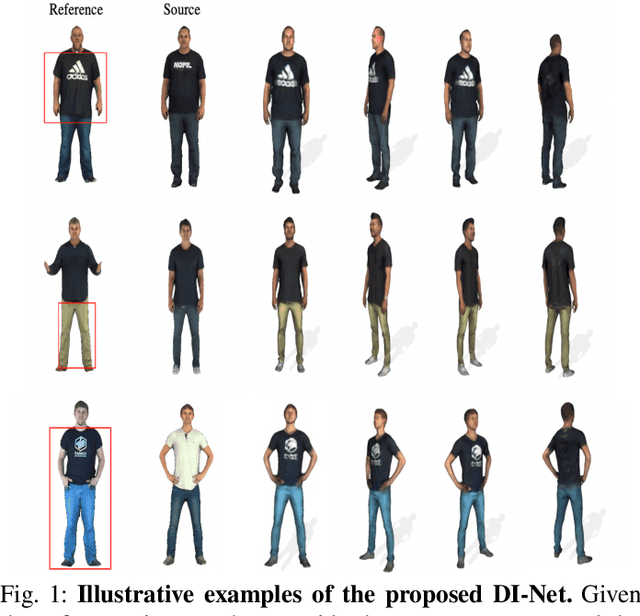
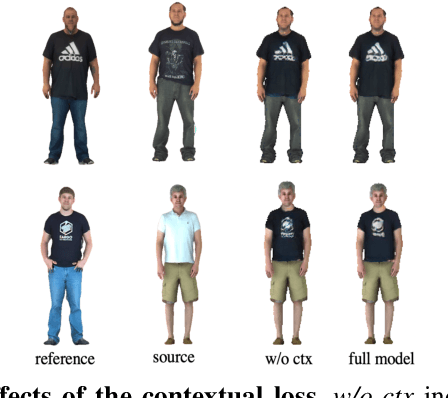
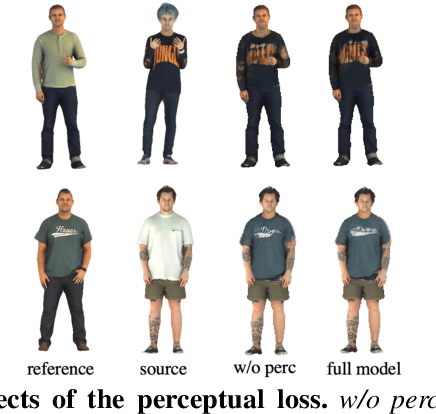
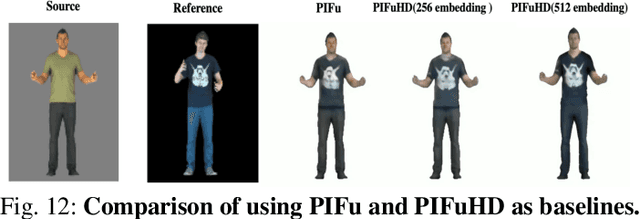
Abstract:3D virtual try-on enjoys many potential applications and hence has attracted wide attention. However, it remains a challenging task that has not been adequately solved. Existing 2D virtual try-on methods cannot be directly extended to 3D since they lack the ability to perceive the depth of each pixel. Besides, 3D virtual try-on approaches are mostly built on the fixed topological structure and with heavy computation. To deal with these problems, we propose a Decomposed Implicit garment transfer network (DI-Net), which can effortlessly reconstruct a 3D human mesh with the newly try-on result and preserve the texture from an arbitrary perspective. Specifically, DI-Net consists of two modules: 1) A complementary warping module that warps the reference image to have the same pose as the source image through dense correspondence learning and sparse flow learning; 2) A geometry-aware decomposed transfer module that decomposes the garment transfer into image layout based transfer and texture based transfer, achieving surface and texture reconstruction by constructing pixel-aligned implicit functions. Experimental results show the effectiveness and superiority of our method in the 3D virtual try-on task, which can yield more high-quality results over other existing methods.
COMNet: Co-Occurrent Matching for Weakly Supervised Semantic Segmentation
Sep 29, 2023

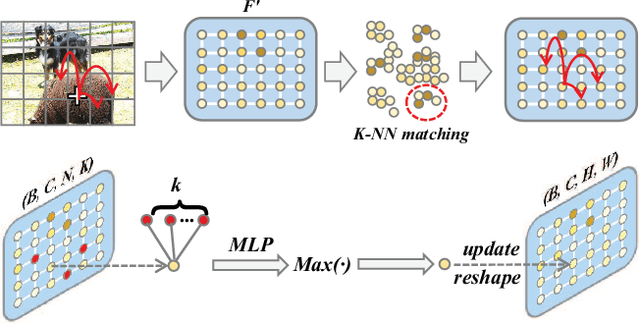
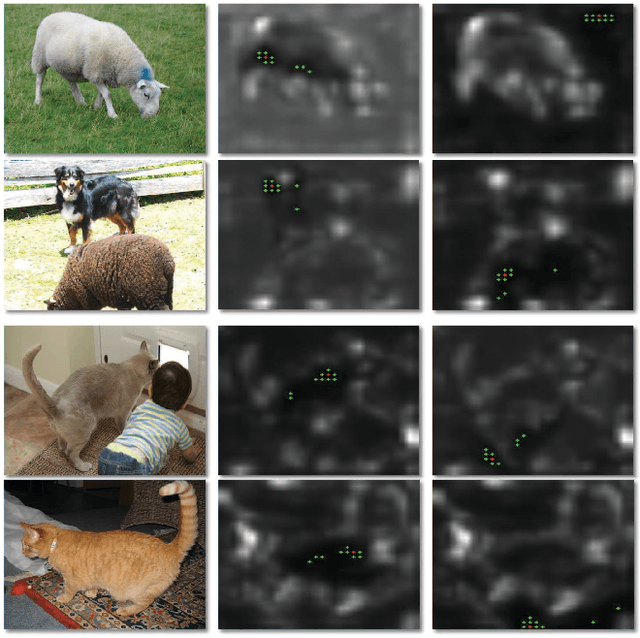
Abstract:Image-level weakly supervised semantic segmentation is a challenging task that has been deeply studied in recent years. Most of the common solutions exploit class activation map (CAM) to locate object regions. However, such response maps generated by the classification network usually focus on discriminative object parts. In this paper, we propose a novel Co-Occurrent Matching Network (COMNet), which can promote the quality of the CAMs and enforce the network to pay attention to the entire parts of objects. Specifically, we perform inter-matching on paired images that contain common classes to enhance the corresponded areas, and construct intra-matching on a single image to propagate the semantic features across the object regions. The experiments on the Pascal VOC 2012 and MS-COCO datasets show that our network can effectively boost the performance of the baseline model and achieve new state-of-the-art performance.
Semantic-Constraint Matching Transformer for Weakly Supervised Object Localization
Sep 04, 2023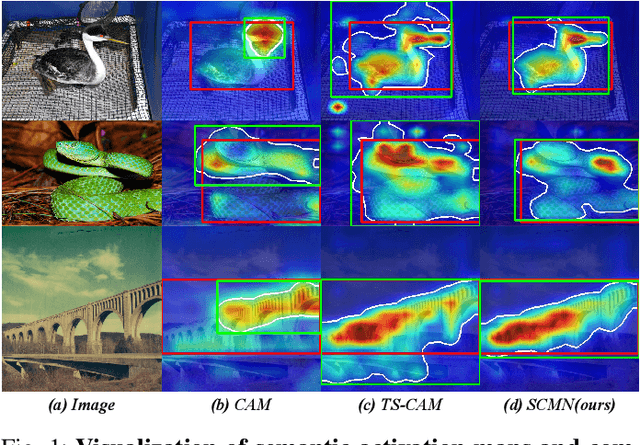

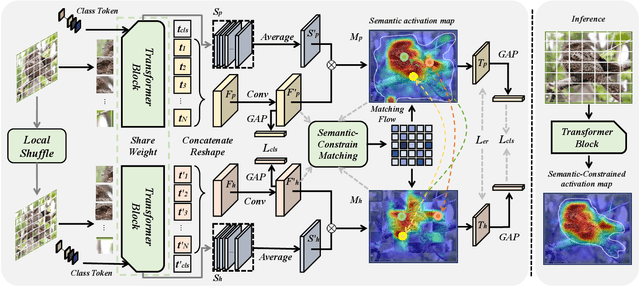
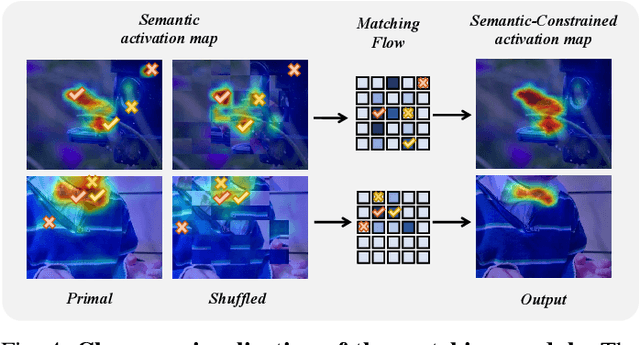
Abstract:Weakly supervised object localization (WSOL) strives to learn to localize objects with only image-level supervision. Due to the local receptive fields generated by convolution operations, previous CNN-based methods suffer from partial activation issues, concentrating on the object's discriminative part instead of the entire entity scope. Benefiting from the capability of the self-attention mechanism to acquire long-range feature dependencies, Vision Transformer has been recently applied to alleviate the local activation drawbacks. However, since the transformer lacks the inductive localization bias that are inherent in CNNs, it may cause a divergent activation problem resulting in an uncertain distinction between foreground and background. In this work, we proposed a novel Semantic-Constraint Matching Network (SCMN) via a transformer to converge on the divergent activation. Specifically, we first propose a local patch shuffle strategy to construct the image pairs, disrupting local patches while guaranteeing global consistency. The paired images that contain the common object in spatial are then fed into the Siamese network encoder. We further design a semantic-constraint matching module, which aims to mine the co-object part by matching the coarse class activation maps (CAMs) extracted from the pair images, thus implicitly guiding and calibrating the transformer network to alleviate the divergent activation. Extensive experimental results conducted on two challenging benchmarks, including CUB-200-2011 and ILSVRC datasets show that our method can achieve the new state-of-the-art performance and outperform the previous method by a large margin.
Occlusion-Aware Detection and Re-ID Calibrated Network for Multi-Object Tracking
Aug 30, 2023Abstract:Multi-Object Tracking (MOT) is a crucial computer vision task that aims to predict the bounding boxes and identities of objects simultaneously. While state-of-the-art methods have made remarkable progress by jointly optimizing the multi-task problems of detection and Re-ID feature learning, yet, few approaches explore to tackle the occlusion issue, which is a long-standing challenge in the MOT field. Generally, occluded objects may hinder the detector from estimating the bounding boxes, resulting in fragmented trajectories. And the learned occluded Re-ID embeddings are less distinct since they contain interferer. To this end, we propose an occlusion-aware detection and Re-ID calibrated network for multi-object tracking, termed as ORCTrack. Specifically, we propose an Occlusion-Aware Attention (OAA) module in the detector that highlights the object features while suppressing the occluded background regions. OAA can serve as a modulator that enhances the detector for some potentially occluded objects. Furthermore, we design a Re-ID embedding matching block based on the optimal transport problem, which focuses on enhancing and calibrating the Re-ID representations through different adjacent frames complementarily. To validate the effectiveness of the proposed method, extensive experiments are conducted on two challenging VisDrone2021-MOT and KITTI benchmarks. Experimental evaluations demonstrate the superiority of our approach, which can achieve new state-of-the-art performance and enjoy high run-time efficiency.
AIoT-Based Drum Transcription Robot using Convolutional Neural Networks
Aug 29, 2023Abstract:With the development of information technology, robot technology has made great progress in various fields. These new technologies enable robots to be used in industry, agriculture, education and other aspects. In this paper, we propose a drum robot that can automatically complete music transcription in real-time, which is based on AIoT and fog computing technology. Specifically, this drum robot system consists of a cloud node for data storage, edge nodes for real-time computing, and data-oriented execution application nodes. In order to analyze drumming music and realize drum transcription, we further propose a light-weight convolutional neural network model to classify drums, which can be more effectively deployed in terminal devices for fast edge calculations. The experimental results show that the proposed system can achieve more competitive performance and enjoy a variety of smart applications and services.
Improving Video Violence Recognition with Human Interaction Learning on 3D Skeleton Point Clouds
Aug 26, 2023



Abstract:Deep learning has proved to be very effective in video action recognition. Video violence recognition attempts to learn the human multi-dynamic behaviours in more complex scenarios. In this work, we develop a method for video violence recognition from a new perspective of skeleton points. Unlike the previous works, we first formulate 3D skeleton point clouds from human skeleton sequences extracted from videos and then perform interaction learning on these 3D skeleton point clouds. Specifically, we propose two types of Skeleton Points Interaction Learning (SPIL) strategies: (i) Local-SPIL: by constructing a specific weight distribution strategy between local regional points, Local-SPIL aims to selectively focus on the most relevant parts of them based on their features and spatial-temporal position information. In order to capture diverse types of relation information, a multi-head mechanism is designed to aggregate different features from independent heads to jointly handle different types of relationships between points. (ii) Global-SPIL: to better learn and refine the features of the unordered and unstructured skeleton points, Global-SPIL employs the self-attention layer that operates directly on the sampled points, which can help to make the output more permutation-invariant and well-suited for our task. Extensive experimental results validate the effectiveness of our approach and show that our model outperforms the existing networks and achieves new state-of-the-art performance on video violence datasets.
Dual Progressive Transformations for Weakly Supervised Semantic Segmentation
Sep 30, 2022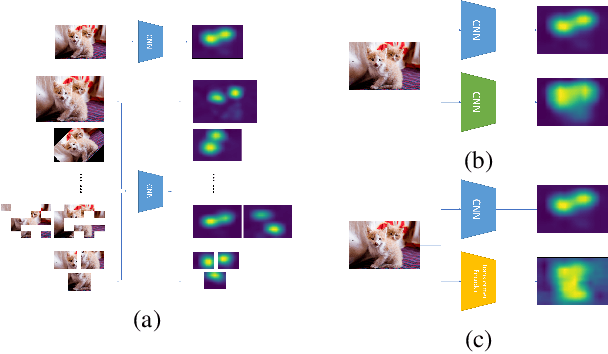


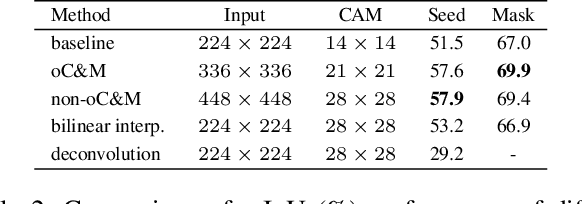
Abstract:Weakly supervised semantic segmentation (WSSS), which aims to mine the object regions by merely using class-level labels, is a challenging task in computer vision. The current state-of-the-art CNN-based methods usually adopt Class-Activation-Maps (CAMs) to highlight the potential areas of the object, however, they may suffer from the part-activated issues. To this end, we try an early attempt to explore the global feature attention mechanism of vision transformer in WSSS task. However, since the transformer lacks the inductive bias as in CNN models, it can not boost the performance directly and may yield the over-activated problems. To tackle these drawbacks, we propose a Convolutional Neural Networks Refined Transformer (CRT) to mine a globally complete and locally accurate class activation maps in this paper. To validate the effectiveness of our proposed method, extensive experiments are conducted on PASCAL VOC 2012 and CUB-200-2011 datasets. Experimental evaluations show that our proposed CRT achieves the new state-of-the-art performance on both the weakly supervised semantic segmentation task the weakly supervised object localization task, which outperform others by a large margin.
A Unified Transformer Framework for Group-based Segmentation: Co-Segmentation, Co-Saliency Detection and Video Salient Object Detection
Mar 11, 2022



Abstract:Humans tend to mine objects by learning from a group of images or several frames of video since we live in a dynamic world. In the computer vision area, many researches focus on co-segmentation (CoS), co-saliency detection (CoSD) and video salient object detection (VSOD) to discover the co-occurrent objects. However, previous approaches design different networks on these similar tasks separately, and they are difficult to apply to each other, which lowers the upper bound of the transferability of deep learning frameworks. Besides, they fail to take full advantage of the cues among inter- and intra-feature within a group of images. In this paper, we introduce a unified framework to tackle these issues, term as UFO (Unified Framework for Co-Object Segmentation). Specifically, we first introduce a transformer block, which views the image feature as a patch token and then captures their long-range dependencies through the self-attention mechanism. This can help the network to excavate the patch structured similarities among the relevant objects. Furthermore, we propose an intra-MLP learning module to produce self-mask to enhance the network to avoid partial activation. Extensive experiments on four CoS benchmarks (PASCAL, iCoseg, Internet and MSRC), three CoSD benchmarks (Cosal2015, CoSOD3k, and CocA) and four VSOD benchmarks (DAVIS16, FBMS, ViSal and SegV2) show that our method outperforms other state-of-the-arts on three different tasks in both accuracy and speed by using the same network architecture , which can reach 140 FPS in real-time.
Context Decoupling Augmentation for Weakly Supervised Semantic Segmentation
Mar 02, 2021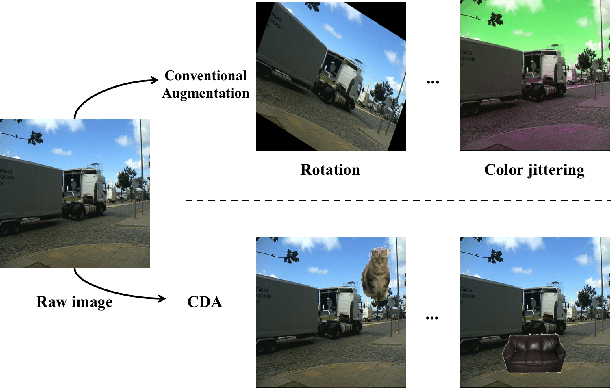
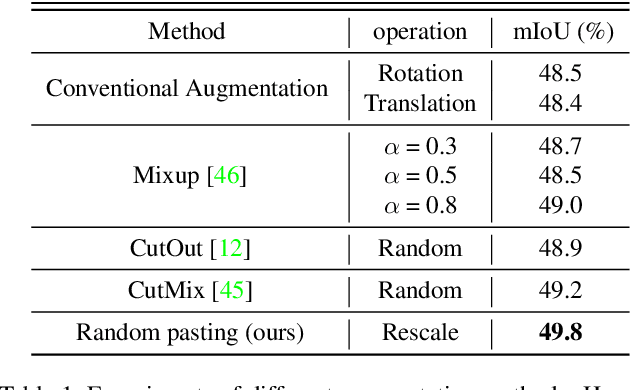
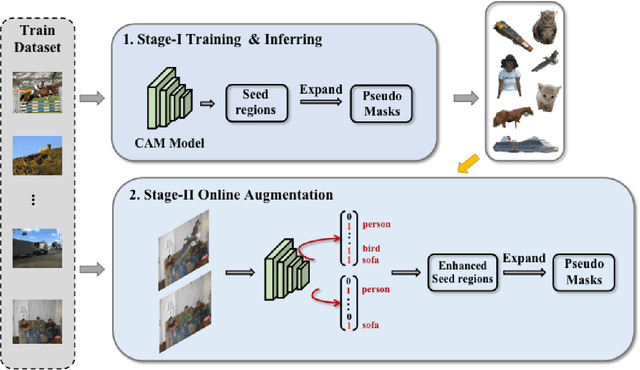
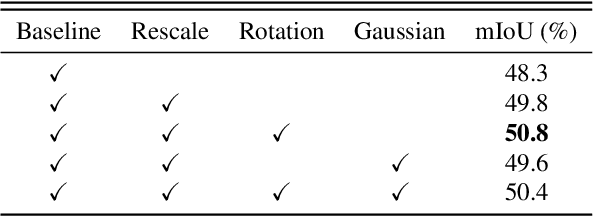
Abstract:Data augmentation is vital for deep learning neural networks. By providing massive training samples, it helps to improve the generalization ability of the model. Weakly supervised semantic segmentation (WSSS) is a challenging problem that has been deeply studied in recent years, conventional data augmentation approaches for WSSS usually employ geometrical transformations, random cropping and color jittering. However, merely increasing the same contextual semantic data does not bring much gain to the networks to distinguish the objects, e.g., the correct image-level classification of "aeroplane" may be not only due to the recognition of the object itself, but also its co-occurrence context like "sky", which will cause the model to focus less on the object features. To this end, we present a Context Decoupling Augmentation (CDA) method, to change the inherent context in which the objects appear and thus drive the network to remove the dependence between object instances and contextual information. To validate the effectiveness of the proposed method, extensive experiments on PASCAL VOC 2012 dataset with several alternative network architectures demonstrate that CDA can boost various popular WSSS methods to the new state-of-the-art by a large margin.
 Add to Chrome
Add to Chrome Add to Firefox
Add to Firefox Add to Edge
Add to Edge